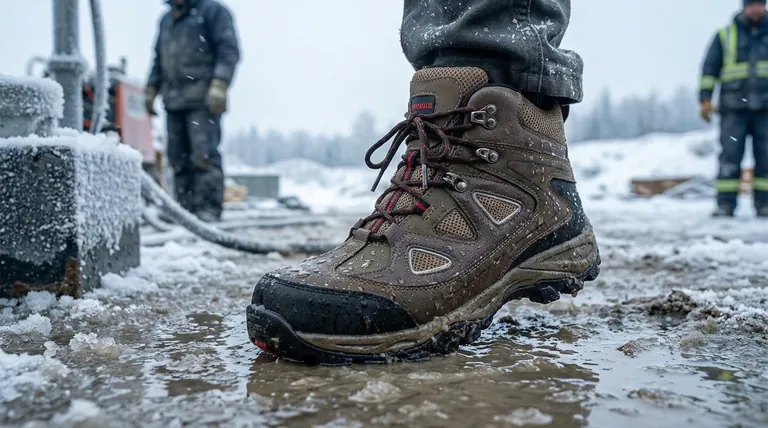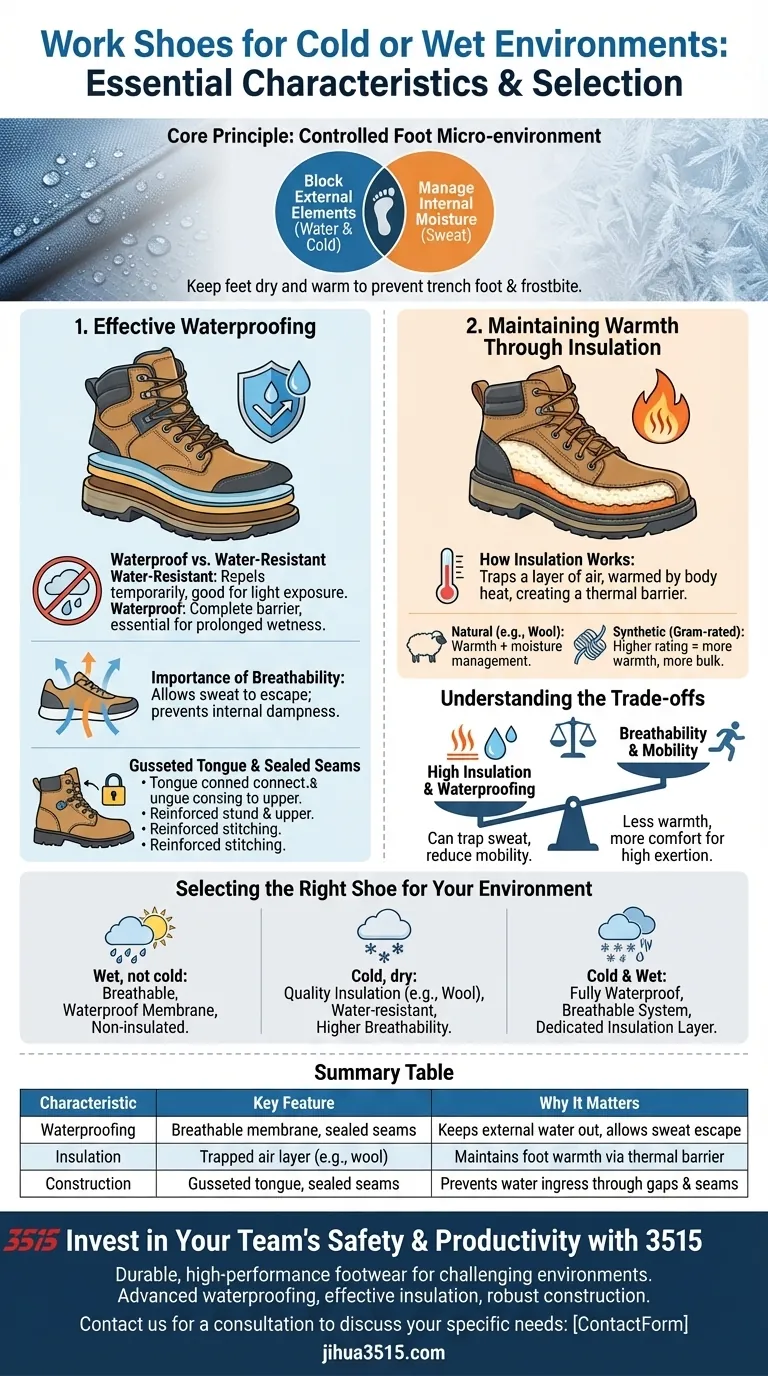For work in cold or wet environments, your footwear must possess two primary characteristics: effective waterproofing and appropriate insulation. These features are non-negotiable for keeping your feet dry and warm, which is essential for preventing discomfort and serious health risks like trench foot or frostbite.
The core principle is to create a controlled micro-environment for your foot. The ideal work shoe doesn't just block external elements like water and cold; it must also manage internal moisture from sweat to ensure your feet remain genuinely dry and comfortable.

The Foundation: Effective Waterproofing
Keeping external moisture out is the first line of defense. However, not all "waterproof" claims are equal, and the construction of the shoe is as critical as the material itself.
Differentiating Waterproof vs. Water-Resistant
Water-resistant materials, such as treated leather, can repel water for a short time but will eventually saturate. They are suitable for light, intermittent exposure to moisture.
Truly waterproof footwear uses materials or internal membranes that form a complete barrier against water, even during prolonged submersion. This is essential for consistently wet conditions.
The Importance of Breathability
The best waterproof systems are also breathable. This allows water vapor (sweat) to escape from inside the shoe.
Without breathability, your feet will become wet from perspiration, defeating the purpose of waterproofing and leading to coldness and discomfort.
Construction is Key
A shoe's overall design is critical. Look for boot construction with sealed seams and a gusseted tongue (a tongue connected to the upper along the sides) to prevent water from seeping in through gaps.
Maintaining Warmth Through Insulation
In cold conditions, waterproofing alone is not enough. You need a material that actively prevents heat from escaping.
How Insulation Works
Insulation works by trapping a layer of air around your foot. This trapped air is then warmed by your body heat, creating a thermal barrier against the external cold.
Common Insulation Materials
Natural materials like wool are an excellent choice, as they provide significant warmth while also managing moisture effectively.
Synthetic insulations are also common and are often rated by grams. A higher gram rating typically signifies more warmth, but also more bulk.
Understanding the Trade-offs
Selecting the right shoe involves balancing competing needs. There is no single perfect solution for every scenario.
The Breathability Compromise
The most heavily waterproofed and insulated boots can sometimes trap more heat and sweat. In high-exertion jobs, this can lead to dampness from the inside if the boot's breathability can't keep up.
Bulk vs. Mobility
Higher levels of insulation add bulk and weight to the shoe. This can slightly reduce mobility and may cause fatigue over a long workday. You must balance the need for warmth with the need for dexterity.
Selecting the Right Shoe for Your Environment
Your specific work conditions should dictate your final choice. Use these guidelines to prioritize features.
- If your primary challenge is a wet but not cold environment: Focus on a breathable, waterproof membrane in a non-insulated shoe to prevent overheating.
- If your primary challenge is a cold but dry environment: Prioritize quality insulation, like wool, with water-resistant materials that offer higher breathability than a full waterproof membrane.
- If you face both cold and wet conditions: You require a shoe that combines a fully waterproof, breathable system with a dedicated insulation layer.
Choosing the right footwear is a direct investment in your safety, comfort, and productivity on the job.
Summary Table:
| Characteristic | Key Feature | Why It Matters |
|---|---|---|
| Waterproofing | Breathable membrane, sealed seams | Keeps external water out while allowing sweat to escape |
| Insulation | Trapped air layer (e.g., wool) | Maintains foot warmth by creating a thermal barrier |
| Construction | Gusseted tongue, sealed seams | Prevents water ingress through gaps and seams |
Invest in the Right Footwear for Your Team's Safety and Productivity
Choosing the correct work shoes for cold or wet conditions is critical for preventing health risks and maintaining comfort. As a large-scale manufacturer, 3515 produces a comprehensive range of durable, high-performance footwear designed specifically for these challenging environments. Our boots feature advanced waterproofing, effective insulation, and robust construction to meet the demands of distributors, brand owners, and bulk clients.
Let us help you equip your workforce with footwear that combines safety, comfort, and durability.
Contact 3515 today for a consultation to discuss your specific needs and explore our full product range.
Visual Guide

Related Products
- Safety Footwear Wholesale Manufacturer for Custom OEM/ODM Production
- Premium High-Cut Waterproof Safety Boots Manufacturing & Wholesale Solutions
- Premium Flame-Retardant Waterproof Safety Boots and Shoes
- Heavy-Duty Waterproof Nubuck Safety Boots Safety Shoes for Bulk Supply
- High Performance Fire-Retardant Waterproof Safety Boots
People Also Ask
- What are OSHA approved shoes? Understanding the Correct Standards for Workplace Safety
- What are the differences between steel toe, composite toe, and alloy toe Wellington boots? Choose the Right Safety Toe for Your Job
- Is safety-toe as good as steel toe? Choose the Right Protection for Your Job
- What do heavy duty boots do? Protect Your Feet in Demanding Work Environments
- Do snake bite boots work? Your Ultimate Guide to Effective Snake Bite Protection



















